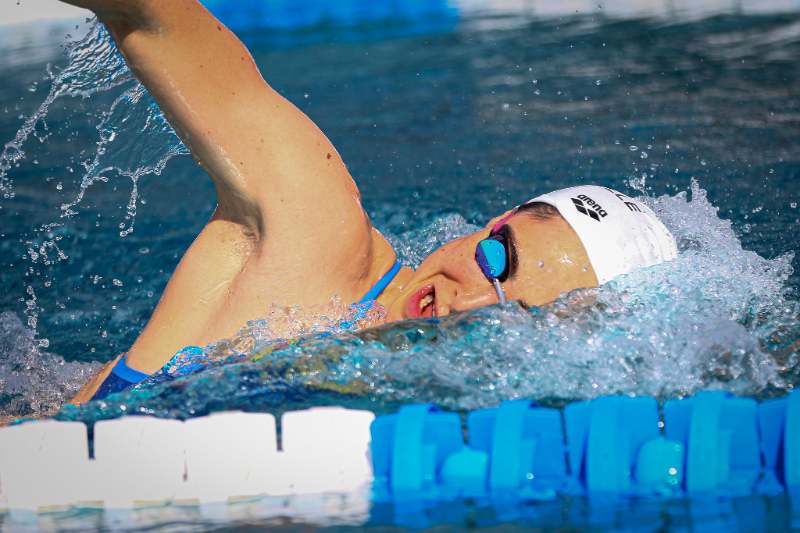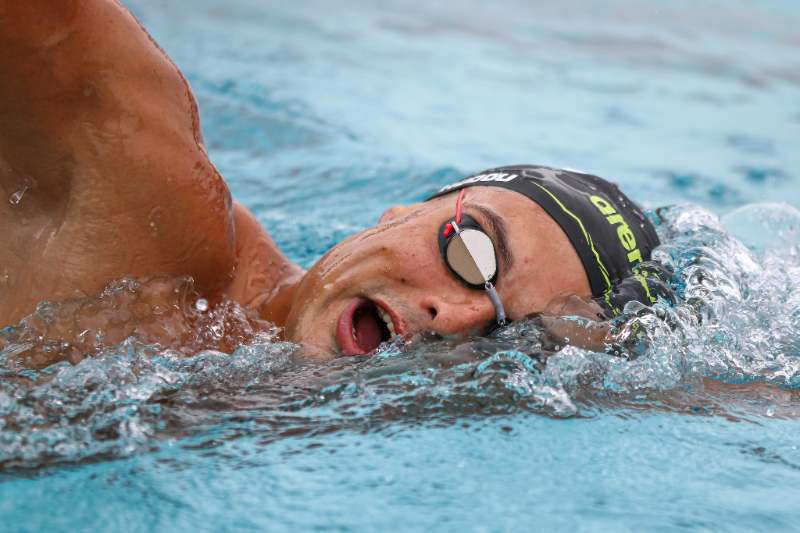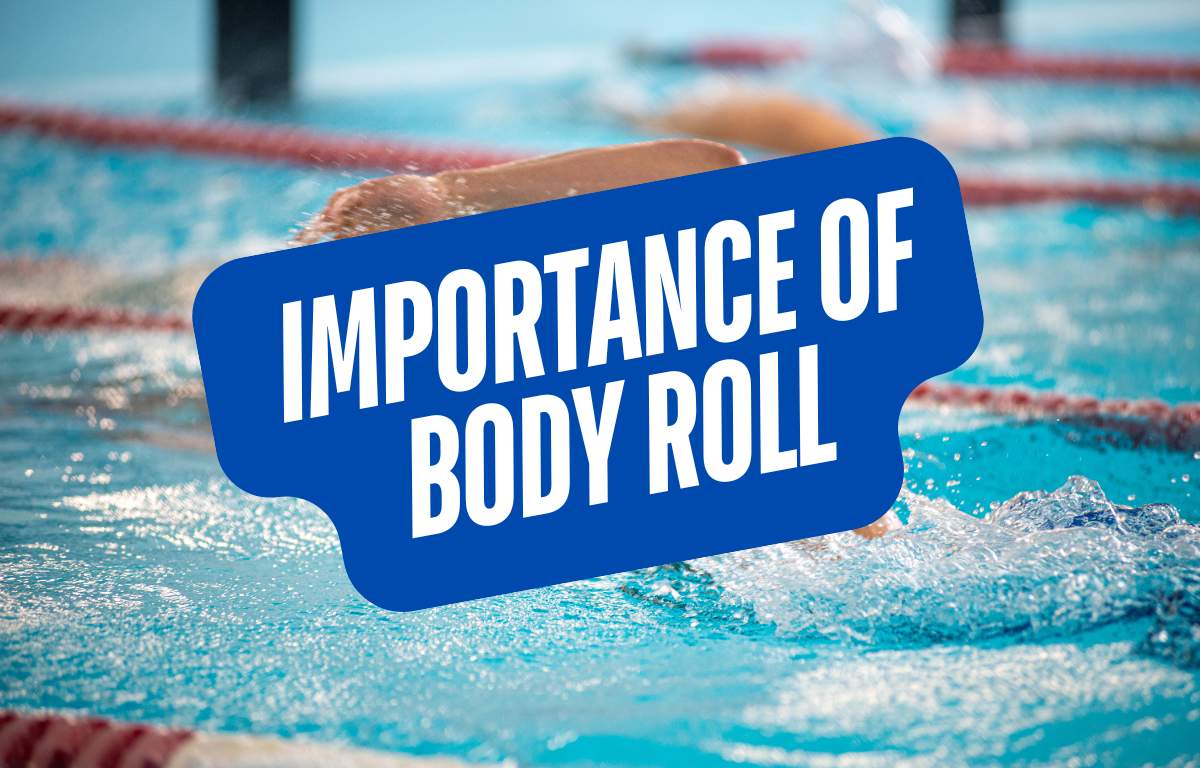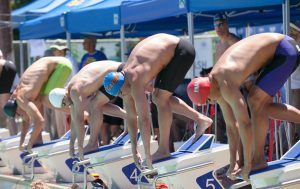Optimal body roll in freestyle is critical for better technique and faster speeds. Here’s why body roll is something you should work on at the pool today.
A fast freestyle stroke is a blend of a strong pull, strong flutter kick, strong catch, clean breathing, and proper hand placement through the pull and push phases of the arm stroke.
But there’s one big element, harder to see and feel but equally important, that holds it all together: body roll.
Body roll is the rotation of the swimmer’s torso around the body’s long axis during freestyle, involving both the hips and shoulders.
Body roll, especially at the hips, is critical for swimming with good technique, lengthening out your stroke, reducing injury, shaping hand path, and ultimately, faster swimming.
Here’s an overview of why body roll is so crucial for fast, efficient swimming.
The Importance of Body Roll in Freestyle
Reasons swimmers should focus on excellent body roll during freestyle include:
- Improved stroke coordination
- Increased distance per stroke
- Reduces drag
- Balanced body position
- Higher power output
- Optimal hand placement
- Reduced injury risk
Next, we will look at each benefit in closer detail.
Improved stroke coordination
A simple way to think about body roll when swimming freestyle is to think of it as a timing belt. As the body rotates with each arm cycle, it creates space for the recovery arm to swing freely over the water while the opposite arm pushes water and creates propulsion.
Body roll helps make this stroke coordination possible.
Without this rhythmic and dynamic rotation, swimmers recover using stiff, flat-arms. The pull isn’t as powerful. And this type of swimming isn’t just flat and slow, it’s also expensive in terms of energy.
Proper body roll lets swimmers flow smoothly from one stroke to the next, maintaining rhythm, leverage, and power.
Increased distance per stroke
Distance per stroke is a key metric for swimmers in the pool. We know that it is a fairly accurate measurement of how efficient we swim.
If you swim 50m of freestyle in 30 seconds, but instead of using 34 strokes, you use 32 strokes, we can broadly say that you’ve increased distance per stroke and become more efficient.
Body roll is a critical part of increasing stroke length. As you roll the hips and shoulders during the reach phase of the stroke, you naturally lengthen out your body, covering more water before initiating the catch of the next stroke.
Reduces drag
The rhythmic back and forth of body roll creates a hydrodynamic body position in the water. The rotation of the shoulders creates a slimmer profile, reducing frontal drag, that allows swimmers to “slice” through the water.
Swimmers that create excessive twist when swimming freestyle (e.g. creating a discrepancy in roll between shoulder and hip roll) create more frontal drag, slowing them down (Psycharakis & Sanders, 2008).

Fast swimmers also create a smooth body roll that reduces herky-jerky movements that cause turbulence and increased drag (Yanai, 2001).
When roll is smoother than butter, consistent, and matches stroke timing, it promotes an aligned body position that reduces drag.
Balanced body position
Being balanced when swimming is more than just literal floatation at the surface of the water. It’s also about maintaining a straight and mega-streamlined body position when swimming fast across the length of the pool.
A high-quality body roll helps to keep our center of mass aligned and reduces speed-killing lateral movements and body wobbling.
Note: For a complete guide at how to improve body roll in freestyle, reference this guide.
Low body roll can lead to a host of freestyle technique errors: Turning the head too far to breathe (compensating for low body roll), extra wide kicks, shoulders over-rotating, and the head tilting. All of which slows us down and leave the body poorly balanced.
Good body roll stabilizes body position and allows swimmers to focus on pulling/pushing/kicking with more gusto instead of scrambling to balance the body.
Higher power output
The hips are the power center of the body, and when they work in sync with the shoulders, swimmers have access to the full kinetic chain (shoulders, core, and legs) when swimming, exerting more power. The alignment between hips and shoulders during body roll allows force to be transferred through the body without leaks or delays.
Slow or no-rolling hips means the shoulders need to increase rotation to clear the arms out of the water and position the hands for the catch.
The hips and shoulders work best when they are on the same page, and good body roll allows swimmers to maximize strength and power from their whole body.
Optimal hand placement
Body roll helps swimmers find the best placement for maximum pressure against the water through the whole stroke.
From that first moment in the catch, when the hand is extending to when it sinks into an early vertical forearm to when peak propulsion happens as the hand passes under the hips.
- Rolling too much or rolling too little can lead to hand placement that is too wide or too narrow at the top of the stroke.
- Unstable hips lead to more sculling during the pull phase of the stroke.
- Without powerful hip angular velocity during the push phase, swimmers are unable to get full thrust from the arm stroke.
The hands are responsible for between 90-97% of the propulsion in the freestyle arm stroke, and good body roll ensures hand placement that leads to more thrust.
Reduced injury risk
Body roll isn’t just about rollickin’ and rollin’ your way across the pool with more speed and less drag. It’s also one of your first lines of defence to reduce injury.
A study by Barden and Barber (2022) analyzing the hip roll of elite competitive freestylers found that swimmers with shoulder pain rolled their hips significantly less to the non-breathing side than pain-free swimmers (49° to 57°).

Why does this matter?
Swimmers shoulder is no joke. In a study of 88 elite Australian swimmers (Sein et al., 2010) over 90% reported shoulder pain, and a whopping 69% were found to have supraspinatus tendinopathy on MRI scans.
Asymmetrical body roll places uneven load on the shoulders, making them more vulnerable to impingement and overuse injuries.
The Bottom Line
Body roll might not get the Bright Lights treatment in the same way as an explosive start, thunderous underwaters, a rooster-tail freestyle kick, or a pool-moving arm stroke.
But it’s the glue that holds all the components of efficient, PB-busting freestyle speeds together.
Get your body roll right, and you’ll swim with a longer and more powerful stroke and also reduce risk of injury along the way.
Roll on and happy swimming!
More Freestyle Technique Articles
How to Increase Your Freestyle Stroke Rate. Is your freestyle stroke rate stuck in first gear? Here is how to ramp up your stroke rate and get your arms turning over fast-fast-fast.
8 Tips for Improving Your Freestyle Stroke. Unlock a faster and more efficient freestyle stroke with this list of eight proven tips for killer freestyle technique.














